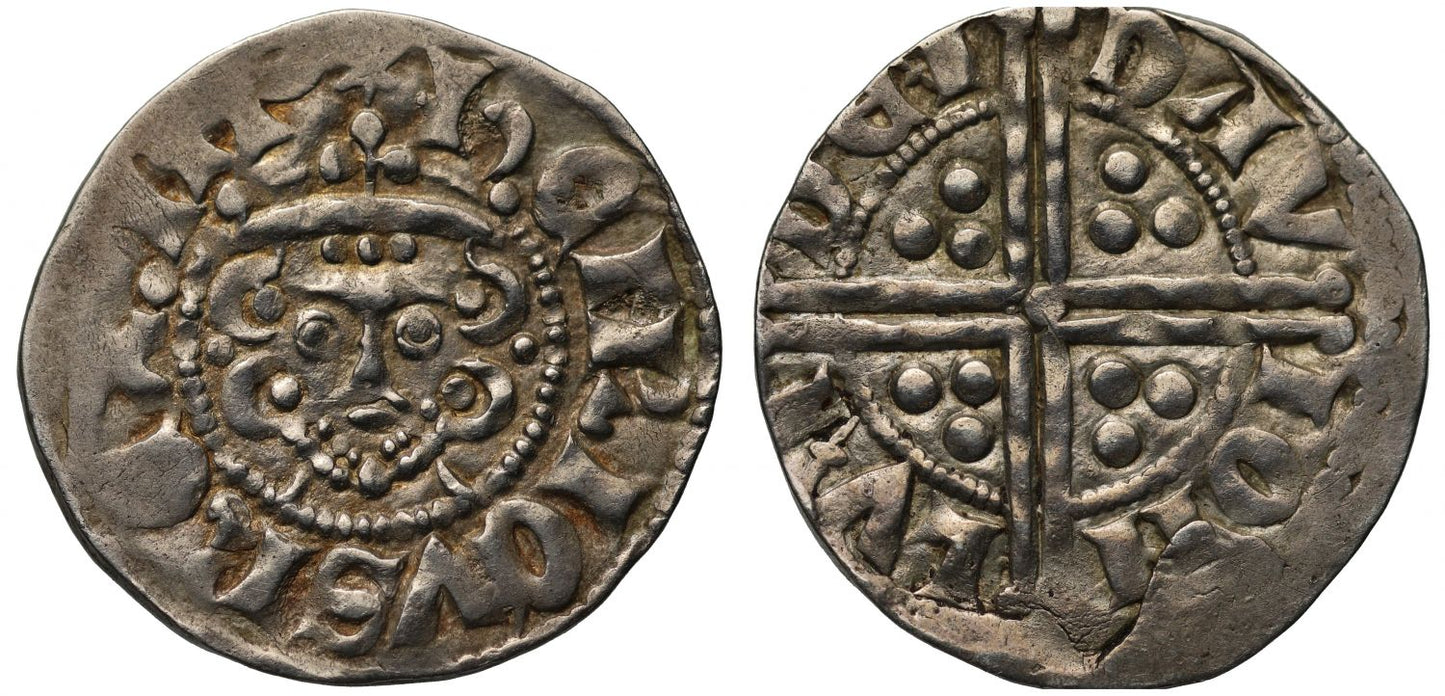FAQs
What makes a coin valuable?
I have coins to sell, what’s the next step?
How will my purchases be shipped?
What happens if I’m not entirely happy with my purchase?
Henry III Long cross Penny, type 3d1, London Mint, Moneyer David
Henry III (1216-72), silver voided long cross Penny, class 3d1 (1247-48), London Mint, moneyer David, facing crowned head, Latin legend and beaded borders surrounding both sides, commences at top, *hENRICVS REX. ANG, rev. long voided cross pommee, trio of pellets in each angle, DAVID ON LON, weight 1.34g (N.988/1; S.1364A). Toned, some weakness around edge with flaws, otherwise a bold very fine and rare.
The obverse Latin legend translates as "Henry King of England" and the reverse as "David of London."
In an effort to curtail clipping of the edges if coins, Henry III was the first to introduce a coinage where the reverse cross extended to towards the rim of the coin so any tampering of the edge would be more obvious to the casual observer. The new design having a voided cross pommée with groups of three pellets in each inner angle. The coinage running for a 32 year period from 1247 until 1279 in the reign of Edward I. The London Mint operated with up to 11 moneyers which was one more than the 10 at Canterbury and run through 5 different classes in this reign with multiple sub-classes and varieties, transitioning into two more later classes in the reign of Edward I.
Nine year old Henry who was born on 1st October 1207 succeeded his Father under the protection of William Marshall on 28th October 1216 with a coronation at Gloucester Cathedral and who reintroduced the terms of the Magna Carta from 1217, after quelling the Baron's rebellion at the battles of Lincoln and Sandwich, under which all future government was based.
At age 18 in 1225 Henry agreed to abide by the Great Charter which was a later version of the Magna Carta limiting Royal power and protecting the barons. Henry was also Lord of Ireland and Duke of Aquitaine and attempted to regain lands in France in 1230 to no avail. A revolt in 1232 by Richard Marshall the son of William was ended by a peace settlement with interaction from the church. Henry preferred to home rule and married Eleanor of Provence in 1236 with whom he had five children, the eldest being the future King Edward I. He was known for piety and charity and adopted Edward the Confessor as his patron saint. He did try invading Poitou in 1242 but suffered defeat at the Battle of Taillebourg and by 1258 his rule at home was becoming unpopular over foreign policy and taxes. A coalition of barons seized power expelling Henry's Poitevin half-brothers and reforming government with the Provisions of Oxford. Henry with the baronial government enacted peace with France in 1259 giving up lands in France in exchange for Louis IX recognising him as ruler of Gascony, but instability later continued. In 1263 the baron Simon De Montfort seized power resulting in a second Baron's War with Henry receiving support from Louis and culminating in the Battle of Lewes in 1264 where Henry was defeated and taken prisoner. Henry's sone Prince Edward came to the rescue by defeating De Montfort killing him at the Battle of Evesham in 1265 and freed King Henry. Henry wanted to exact revenge on the rebels but was persuaded by the church through the Dictum of Kenilworth of 31st October 1266 to take a less harder line and reconcile. Henry died after recurring illness on 16th November 1272 after the longest Medieval reign in English history and is buried in Westminster Abbey.
Capital City London upon the River Thames following Roman occupation, minted some of the earliest Saxon coins with gold Thrymsas and silver denarii with a "Londuniu" signature. Mercian Kings beginning with Offa minted coins there, but the first coin to actually say City of London upon it is the unique Ludica portrait Penny that was found in 2016, followed by subsequent coins of Ecgberht. In 871 the Danes wintered in London for the first time but was King Alfred of Wessex who settled and fortified the capital circa 880 to resist further invasions. Edward the Elder incorporated the City in Wessex in 911 and it resisted a major attack in the reign of Aethelred II in 1009. However, London submitted to the Danish Swein in 1013, but three years later the citizens accepted Eadmund Ironside as King and resisted a siege by Canute.
Later unsettled times occurred in the anarchy period of the reign of King Stephen, remaining loyal to the King except for a few months in 1141 when Empress Matilda was admitted but within a short time expelled. Coinage activity here has been mostly constant throughout history from the Romans until the reign of our current Queen and only moving out to Wales from 1969.
Provenance:
Ex Classical Numismatic Group, E-Sale 458, 18th December 2019, lot 695.
Ex Collection of an English Doctor part III, Sovereign Rarities fixed price list online August 2022.
FAQs
What makes a coin valuable?
I have coins to sell, what’s the next step?
How will my purchases be shipped?
What happens if I’m not entirely happy with my purchase?













